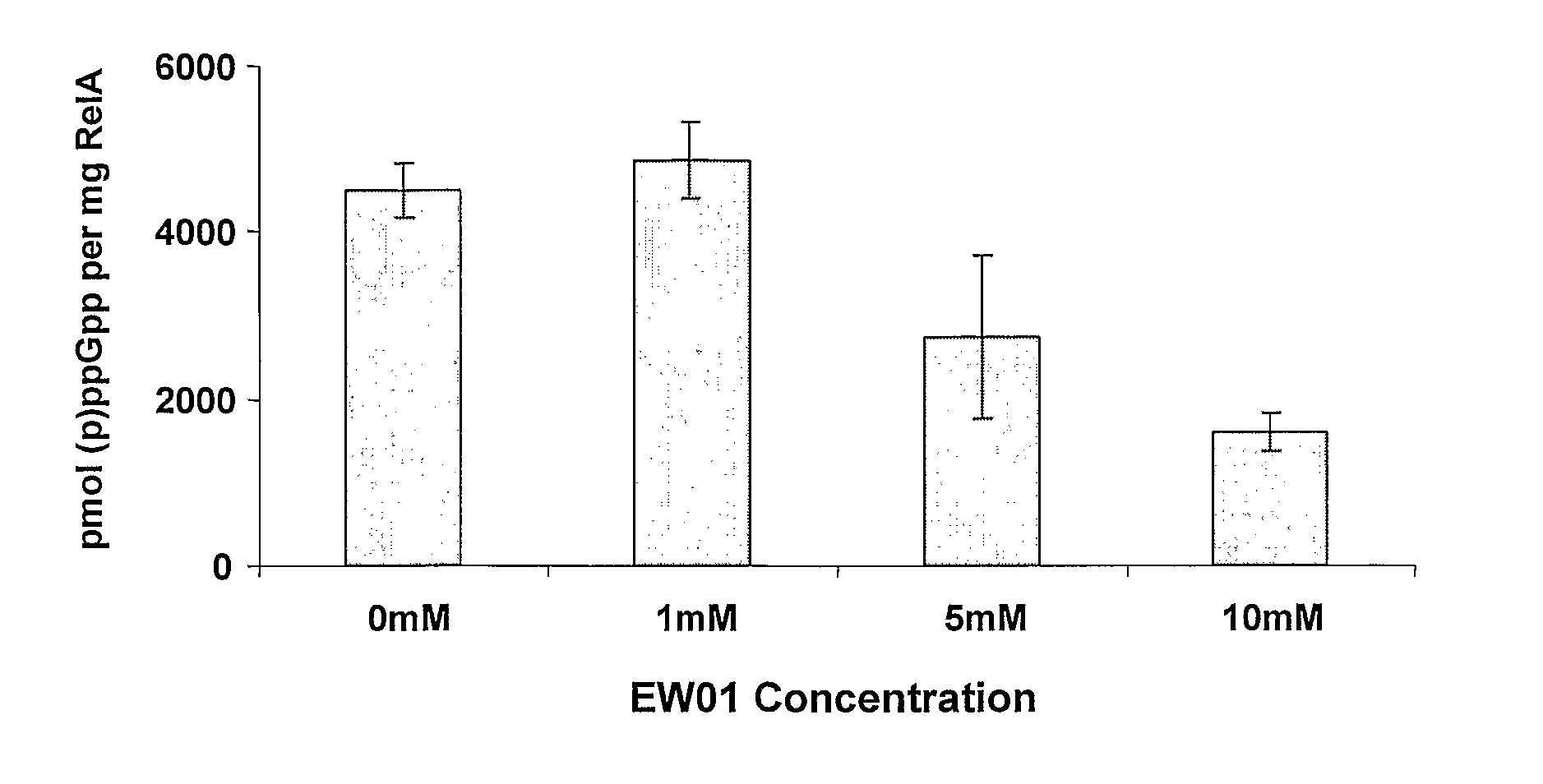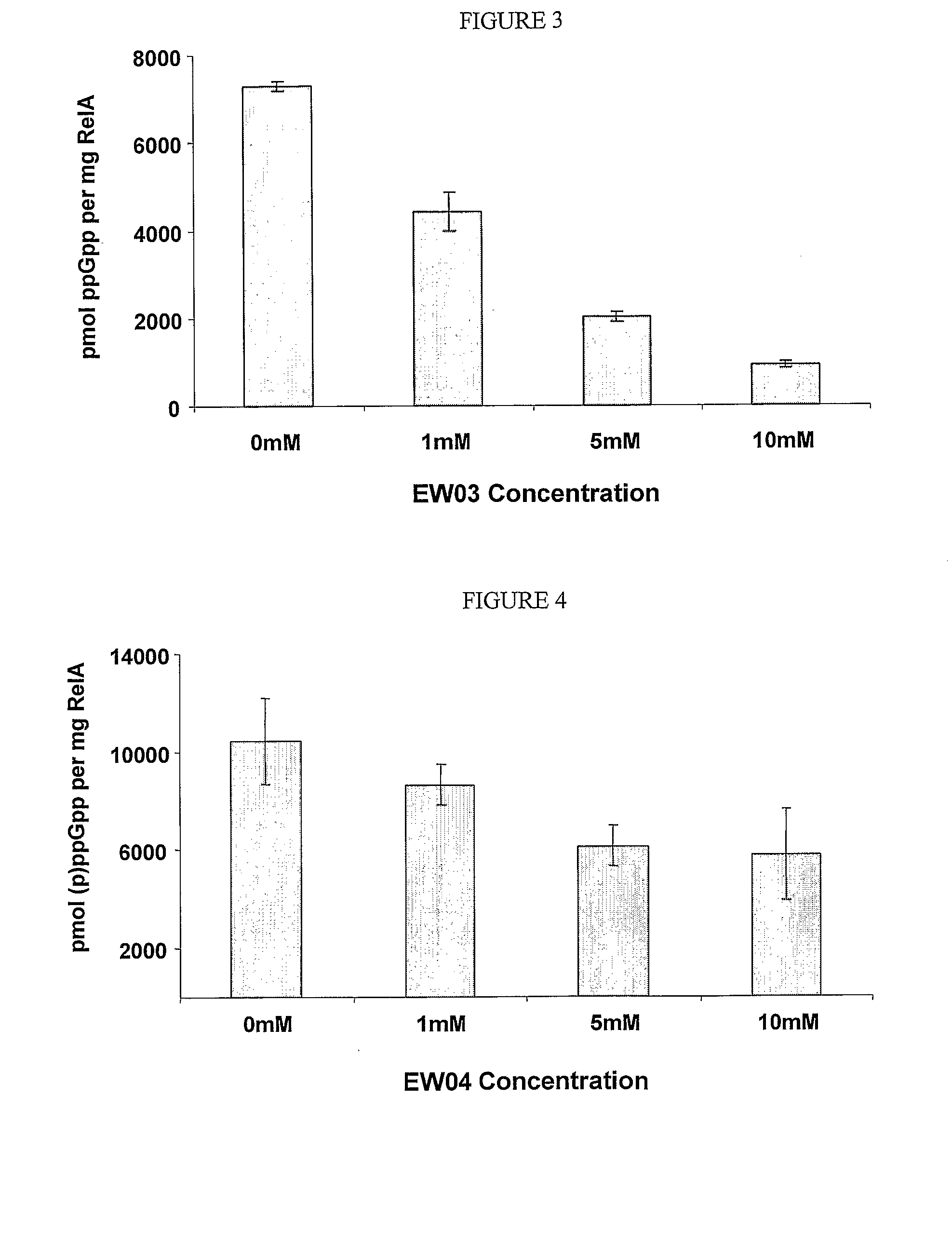Compounds for treating bacterial infections
- Summary
- Abstract
- Description
- Claims
- Application Information
AI Technical Summary
Benefits of technology
Problems solved by technology
Method used
Image
Examples
example 1
EXAMPLE 1
Synthesis Procedures
Group A—3′(2′) (Phosphate)
Preparation of A4 where Y═CH2 and X═H
Step 1—2N-Isobutyryl-3′-O-(2-Cyanoethyl)H-Phosphonate-5′O-Dimetoxytrityl deoxyguanosine (A4-I)
[0242]2N-Isobutyryl-50-Dimetoxytrityl deoxyguanosine (0.5 g, 0.78 mmol) was dried by co-evaporation with dry toluene and suspended in dry pyridine (10 mL) under inert atmosphere. Diphenyl phosphite (250 μL, 1.3 mmol) was added and stirred for 2 h. 3-hydroxypropionitrile (150 μL, 2.16 mmol) was added. After stirring for 2 hr, the solvent was evaporated. The oily crude was used without further purification.
Step 2—2N-Isobutyryl-3′-O-(2-Cyanoethyl)H-Phosphonate-deoxyguanosine (A4-II)
[0243]400 mg of A4-I were dissolved in 20 mL of 3% TCA in DCM and stirred for 20 minutes. The solvent was evaporated and the crude partitioned between DCM and aq. NH4HCO3 (20 mL each). The organic phase was washed twice with ammonium bicarbonate and twice with water. Then it was dried over anhydrous Na2SO4, filtered and conc...
example 2
EXAMPLE 2
Experimental Procedures
A. Cell Growing:
[0307]Starters of deltaRelA E. coli cells, expressing one of the following proteins (RelA, RelA638 or Relseq385) in trans, were grown overnight at 37° C. The next day, the starters were diluted 1:50 in 400 ml LBamp and the cells have continued to grow at 37° C. until they reached O.D600=˜0.6. Then, the cells were added with IPTG (1 mg / ml) and the cells were grown at the same conditions for additional 2-3 h. After that the cells were harvested for 10 min at 4000 rpm and the pellet was frozen at −80° C.
Protein Purification:
[0308]Lysis of the pellet using “Lysis Buffer” containing Lysozyme (3 mg / ml) and ½ pill of Complete (EDTA-free).[0309]Sonication on ice for 3.5 min.[0310]Centrifuge the cells for 10 min at 10000 rpm.[0311]Mix the supernatant with Ni-NTA bids for 1 h at 4° C.[0312]Load the bids on a column and wash it with “Wash Buffer”.[0313]Elute the protein using “Elution Buffer”.
[0314]The elution fractions were run on 12% Acryl / Bis...
example 3
EXAMPLE 3
Results
[0324]The effects of the newly purified (p)ppGpp analogues A1 (or EW01) (FIG. 1), E3b, i.e., E3 where Y═CH2 (or EW02) (FIG. 2), D3 (or EW 03) (FIG. 3), D7 (or EW 04) (FIG. 4), D8 (or EW 05) (FIG. 5) or D6 (or EW 07) (FIG. 6) on Gram Negative E. coli RelA in vitro activity were examined. Each of the analogues were added and the effects of each compound on (p)ppGpp accumulation were measured. Results are presented as pmol (p)ppGpp per mg RelA vs. compound concentrations.
[0325]In a separate experiment, the effects of the (p)ppGpp analogues A1 (FIG. 8), E3b (FIG. 9), D3 (FIG. 10), D7 (FIG. 11), D8 (FIG. 12), D6 (FIG. 13), D1c (FIG. 14), D2b (FIG. 15) and D2c (FIG. 16) on Gram Negative E. coli RelA in vitro activity were examined. Each of the analogues were added and the effects of each compound on (p)ppGpp accumulation were measured. Results are presented % inhibition vs. compound concentration.
[0326]As seen, all of the tested compounds inhibited E. coli RelA in vitro a...
PUM
| Property | Measurement | Unit |
|---|---|---|
| Composition | aaaaa | aaaaa |
Abstract
Description
Claims
Application Information
 Login to View More
Login to View More - R&D
- Intellectual Property
- Life Sciences
- Materials
- Tech Scout
- Unparalleled Data Quality
- Higher Quality Content
- 60% Fewer Hallucinations
Browse by: Latest US Patents, China's latest patents, Technical Efficacy Thesaurus, Application Domain, Technology Topic, Popular Technical Reports.
© 2025 PatSnap. All rights reserved.Legal|Privacy policy|Modern Slavery Act Transparency Statement|Sitemap|About US| Contact US: help@patsnap.com



